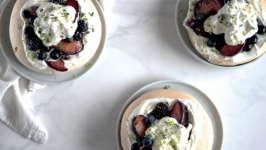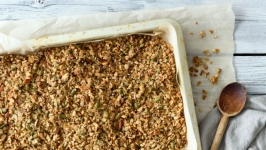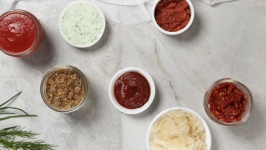Baker's Intuition
Andrea Mastrandrea peels open a five-gallon bucket and I peek in. When I asked if he’d let me see inside, I wasn’t sure he would say yes. In that bucket, he keeps six decades of history, along with the memory of his father and grandfather and a great deal of love for his ancestral land of Puglia, Italy. In many ways, the contents are sacred and personal. But they also feed many Torontonians.
What I see — and smell — is bubbling, sweet and fruity natural leaven, Mastrandrea's coveted sourdough starter. For the past eight years, Mastrandrea has nurtured this particular mother culture. With it, he and his bakers at Forno Cultura on King Street West make some of Toronto’s best bread and pastries.
During our conversation, Mastrandrea tells me about the peculiarities of his sourdough culture, about his philosophy of baking and the way he embraces art, science and intuition.
In the simplest terms, the science of sourdough comes down to wild bacteria and yeasts that exist on wheat and in the surrounding environment at any given time. The baker coaxes those microbes to thrive, by “feeding” them a regular supply of flour and water and by keeping a relatively cool ambient temperature.
A good starter is one where the Lactobacillales or lactic acid bacteria, which provides that signature sour taste, is kept in check, allowing the yeasts to thrive as well.
If well cared for, a starter can be kept alive indefinitely. Some have been known to be handed down through generations and have made their way across oceans with emigrating bakers. Sourdough starters can be imbued with family history, each loaf, a moment in time.
What lives in a bucket at Forno Cultura today started in Puglia, where Mastrandrea’s grandfather was the local baker. The city of Altamura in Puglia is renowned for its bread and wheat, Mastrandrea explains.
“It’s one of the only protected single-grain wheats that have been traced back to its origin,” he says. “It’s got a very particular flavour profile.”
We can continue to trace Mastrandrea starter’s history from the heel of Italy to the North of the country, where his father studied in the seminary before becoming a baker. He incorporated what he learned baking in those kitchens into the family starter.
When Mastrandrea’s father moved to Canada in the 1960s he took that starter with him. He opened a bakery near Old Weston Road and Sheppard Avenue, and for a good 40 years, his father was the starter’s sole caretaker.
“My father’s sourdough culture is quite old, so it’s quite aggressive, quite strong tasting,” Mastrandrea says. “It has a very particular flavour profile and it was fantastic for the kind of bread my father made.”
However, when Mastrandrea took some of this heritage starter for his own bread, he wanted to change its character and make it his own. That meant incorporating his own terroir — the Ontarian landscape — into this Italian starter.
Mastrandrea says that the local fruit he had been eating that summer — peaches, apricots and cherries — ended up feeding his starter. Like a notch in wood, these fruit-infused feedings marked a new chapter in the starter’s history.
The fully ripened fruit were placed in a sealed jar to ferment. After about 10 days, the naturally occurring yeast on the fruit is fed by the fruit’s sugars and begins to bubble, signalling live fermentation. The liquid it created was introduced into Mastrandrea’s father’s original culture.
“What came out of it is actually something quite pleasant, more fruitful, a little more balanced. It allows us to make a variety of breads,” Mastrandrea explains, adding that it was a very personal process.
A few years ago, Mastrandrea did something very difficult for a baker: He allowed his employees to care for his starter. “This mother culture is going on eight years, it’s starting to gain its own inherent strength,” he says.
Like his father’s starter, it’s starting to grow more robust. “It has a little more tolerance for the human element. That was put to the test when I let it go and got my bakers to care for it. There were quite a few times when it almost got killed, and fortunately, we were able to bring it back. In that process, it developed a certain strength.”
For a young baker, earning Mastrandrea’s trust is a mark of success. The bread that comes from his bakery is among the best in the city. The American-published Bon Appetit magazine recently raved about it calling it “bread porn for sourdough fanatics.”
In ancient times, using wild yeast to ferment bread dough was standard practice in wheat-producing regions of the world. The first loaves of bread were likely a form of sourdough, where a portion of the dough from each baking session would be saved and fermented for the next session.
Baker’s yeast — the commercial yeast you’ll find in the baking aisle at the grocery store — changed baking forever when it was introduced to bakers about a century ago. At first, suspicious bakers experimented by combining commercial yeasts with their well-tended beloved leaven. Consumers and bakers alike warmed up to commercial yeast in this hybrid form and it quickly replaced natural leaven in most bakeries.
Using commercial yeast is speedier, both in the home kitchen and the bakery. But the end result lacks the flavour and complexity of sourdough. Chad Robertson, a renowned American baker and co-owner of Tartine Bakery in San Francisco, wrote about this chapter in French bread history in his best-selling cookbook, Tartine Bread.
“Bread that was once revered around the world now gained a reputation for staling within hours. Consumers balked. Although bread was still considered the staple of the French diet, historians note that bread consumption in France sharply declined after the 1940s,” Robertson writes.
Across Europe and North America, commercial bakers had caught the commercial yeast bug. It became hard to find a decent loaf of bread.
Luckily, there were a few bakers, such as Mastrandrea’s father, who knew natural leaven was something to treasure. There was also Raymond Cavel, a French bread expert who taught Julia Child, among many others. Cavel is credited with bringing good, fermented bread back to France. His intensive studies on the science of sourdough changed the way bakers approached the process.
In the 1970s, European bakers were reawakened to natural leaven. A decade later, North American bakers were selling sourdough breads once again.
In the last decade or so, books such as Robertson’s Tartine Bread or Peter Reinhart’s The Bread Baker’s Apprentice have emboldened amateur bakers.
Mastrandrea loves this phenomenon. He tells me about a friend who took on home baking during a year-long paternity leave. “He would bring me his loaves and we would troubleshoot what he could do next time to make his bread even better.”
Looking at the elaborate stainless-steel technology in Forno Cultura’s kitchen, you could conclude that fermented dough has been stripped down to a science since its renaissance over the last few decades. The various stages of making a loaf of bread are better understood.
The technical side of baking is important, says Mastrandrea, but he insists his most important tool is his own body. “Let’s not discount that the body the most technically complicated piece of equipment available to a baker."
Over the years, growing up in his father’s bakery, he learned that his senses tell him everything he needs to know about his bread. How does the dough feel in his hands? How does the starter smell? How does the finish product taste? Armed with a storied sourdough starter, patience and a passion for the artform, a baker’s intuition is the best tool.
Forno Cultura
609 King St. W., Toronto, Ont.
fornocultura.com | 416.603.8305



















